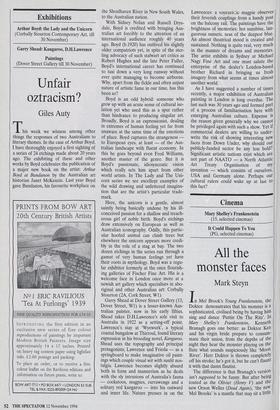Exhibitions
Arthur Boyd: the Lady and the Unicorn (Corbally Stourton Contemporary Art, till 30 November) Garry Shead: Kangaroo, D.H.Lawrence Paintings (Dover Street Gallery till 30 November)
Unfair ortracism?
Giles Auty
This week we witness among other things the responses of two Australians to literary themes. In the case of Arthur Boyd, I have thoroughly enjoyed a first sighting of a series of 24 etchings made about 20 years ago. The exhibiting of these and other works by Boyd celebrates the publication of a major new book on the artist: Arthur Boyd at Bundanon by the Australian art historian Janet McKenzie. Last year Boyd gave Bundanon, his favourite workplace on the Shoalhaven River in New South Wales, to the Australian nation.
With Sidney Nolan and Russell Drys- dale, Boyd is credited with bringing Aus- tralian art forcibly to the attention of an international audience roughly 40 years ago. Boyd (b.1920) has outlived his slightly older compatriots yet, in spite of the ster- ling advocacy of such stalwart art critics as Robert Hughes and the late Peter Fuller, Boyd's international career has continued to taxi down a very long runway without ever quite managing to become airborne. Why, apart from the fickle and often unjust nature of artistic fame in our time, has this been so?
Boyd is an odd hybrid: someone who grew up with an acute sense of cultural iso- lation yet who used this as a spur rather than hindrance to producing singular art. Broadly, Boyd is an expressionist, dealing in extremes of human feeling yet far from unaware at the same time of the emotions of place. Boyd captures the strangeness to European eyes, at least — of the Aus- tralian landscape with fluent economy. In this he goes beyond even Fred Williams, another master of the genre. But it is Boyd's passionate, idiosyncratic vision which really sets him apart from other world artists. In The Lady and The Uni- corn series we see excellent examples of the wild drawing and unfettered imagina- tion that are the artist's particular trade- mark.
Here, the unicorn is a gentle, almost saintly being basically undone by his ill- conceived passion for a shallow and treach- erous girl of noble birth. Boyd's etchings draw extensively on European as well as Australian iconography. Oddly, this partic- ular hoofed animal can climb trees but elsewhere the unicorn appears more credi- bly in the role of a stag at bay. The two dozen etchings in the series run through a gamut of very human feelings yet have their roots in mythology. Boyd was a regu- lar exhibitor formerly at the once flourish- ing galleries of Fischer Fine Art. His is a welcome face in London once more at a newish art gallery which specialises in abo- riginal and other Australian art: Corbally Stourton (2A, Cork Street, W1).
Garry Shead at Dover Street Gallery (13, Dover Street, W1) is a lesser-known Aus- tralian painter, now in his early fifties. Shead takes D.H.Lawrence's sole visit to Australia in 1922 as a setting-off point. Lawrence's stay at `Wyewurk', a typical coastal bungalow at Thirroul, found literary expression in his brooding novel, Kangaroo. Shead uses the topography and principal protagonists; Lawrence and Frieda — as a springboard to make imaginative oil paint- ings which couple visual wit with sunlit nos- talgia. Lawrence becomes slightly absurd both in form and mannerism as he deals with the sly intrusions of Australia's fauna — cockatoos, magpies, currawongs and a solitary red kangaroo — into his outward and inner life. Nature presses in on the Lawrences: a voyeuriE:ic magpie observes their feverish couplings from a handy post on the balcony rail. The paintings have the brightness of memories: hot sunshine, lan- guorous sunsets, seas of the deepest blue. An almost theatrical mood is created and sustained. Nothing is quite real, very much in the manner of dreams and memories. The artist exhibits in Sydney at Michael Nagy Fine Art and one must salute the enterprise of the dealer's London-based brother Richard in bringing us fresh imagery from what seems at times almost another world.
As I have suggested a number of times recently, a major exhibition of Australian painting in London is long overdue. The last such was 30 years ago and formed part of a process of familiarisation here with emerging Australian culture. Expense is the reason given generally why we cannot be privileged again with such a show. Yet if commercial dealers are willing to under- write the risk of showing interesting new faces from Down Under, why should our publicly-funded sector be any less bold? Significant artistic nations exist which are not part of NAATO — a North Atlantic Art Treaty Organisation of my invention — which consists of ourselves, USA and Germany alone. Perhaps our cultural rulers could wake up at last to this fact?


































































 Previous page
Previous page